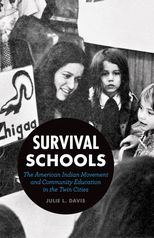Survival Schools: The American Indian Movement and Community Education in the Twin Cities
Survival Schools: The American Indian Movement and Community Education in the Twin Cities
Cite
Abstract
This book provides the first history of the AIM survival schools, two alternative, culture-based, community-controlled schools founded by American Indian Movement organizers and other Indian parents in the Twin Cities of Minneapolis and St. Paul in 1972. It tells a compelling story of the schools’ origins, structure, curriculum, evolution, closing, impact, and meanings from 1968 to 2008. Davis explains how the survival schools emerged out of AIM’s local activism in education, child welfare, and juvenile justice and its efforts to achieve self-determination over urban Indian institutions. At the Heart of the Earth School in Minneapolis and the Red School House in St. Paul, AIM organizers and other local Indian people worked to nurture the identity development of Native youth through an educational system grounded in traditional Indigenous knowledge, infused with social consciousness, galvanized by political action, and anchored by a commitment to community. Over time, the schools themselves would become a center for Indigenous community in the Twin Cities and the upper Midwest region. Davis argues that the people of the survival schools practiced Indigenous decolonization. They resisted American settler colonialism’s “logic of elimination” by repairing the losses incurred through past assimilation policies and rejecting the ongoing assimilationist imperative at work in post-World War Two urban society. Survival school educators also contributed to the transnational Indigenous decolonization movement by restoring connections to individual and collective Indigenous identities; rebuilding Native family and community structures; and revitalizing Indigenous languages, cultural knowledge, and spiritual systems.
-
Front Matter
- Introduction Not Just a Bunch of Radicals: A History of the Survival Schools
-
1
The Origins of the Twin Cities Indian Community and the American Indian Movement
-
2
Keeping Ourselves Together: Education, Child Welfare, and Aim’s Advocacy for Indian Families, 1968–1972
-
3
From One World to Another: Creating Alternative Indian Schools
-
4
Building Our Own Communities: Survival School Curriculum, 1972 –1982
-
5
Conflict, Adaptation, Continuity, and Closure, 1982–2008
-
6
The Meanings of Survival School Education: Identity, Self-Determination, and Decolonization
- Conclusion The Global Importance of Indigenous Education
-
End Matter
Sign in
Personal account
- Sign in with email/username & password
- Get email alerts
- Save searches
- Purchase content
- Activate your purchase/trial code
Institutional access
-
Sign in through your institution
- Sign in with a library card Sign in with username/password Recommend to your librarian
Institutional account management
Sign in as administratorPurchase
Our books are available by subscription or purchase to libraries and institutions.
Purchasing information| Month: | Total Views: |
|---|---|
| November 2023 | 3 |
| November 2023 | 1 |
| November 2023 | 1 |
| November 2023 | 4 |



Get help with access
Institutional access
Access to content on Oxford Academic is often provided through institutional subscriptions and purchases. If you are a member of an institution with an active account, you may be able to access content in one of the following ways:
IP based access
Typically, access is provided across an institutional network to a range of IP addresses. This authentication occurs automatically, and it is not possible to sign out of an IP authenticated account.
Sign in through your institution
Choose this option to get remote access when outside your institution. Shibboleth/Open Athens technology is used to provide single sign-on between your institution’s website and Oxford Academic.
If your institution is not listed or you cannot sign in to your institution’s website, please contact your librarian or administrator.
Sign in with a library card
Enter your library card number to sign in. If you cannot sign in, please contact your librarian.
Society Members
Society member access to a journal is achieved in one of the following ways:
Sign in through society site
Many societies offer single sign-on between the society website and Oxford Academic. If you see ‘Sign in through society site’ in the sign in pane within a journal:
If you do not have a society account or have forgotten your username or password, please contact your society.
Sign in using a personal account
Some societies use Oxford Academic personal accounts to provide access to their members. See below.
Personal account
A personal account can be used to get email alerts, save searches, purchase content, and activate subscriptions.
Some societies use Oxford Academic personal accounts to provide access to their members.
Viewing your signed in accounts
Click the account icon in the top right to:
Signed in but can't access content
Oxford Academic is home to a wide variety of products. The institutional subscription may not cover the content that you are trying to access. If you believe you should have access to that content, please contact your librarian.
Institutional account management
For librarians and administrators, your personal account also provides access to institutional account management. Here you will find options to view and activate subscriptions, manage institutional settings and access options, access usage statistics, and more.